
Saxifraga is the largest genus in the family Saxifragaceae, containing about 473 species of holarctic perennial plants, known as saxifrages or rockfoils. The Latin word saxifraga means literally "stone-breaker", from Latin saxum + frangere. It is usually thought to indicate a medicinal use for treatment of urinary calculi, rather than breaking rocks apart.
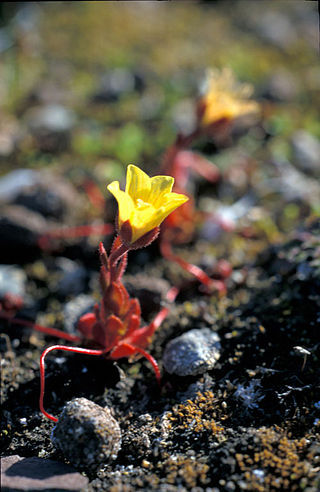
Saxifraga flagellaris, the whiplash saxifrage or flagellate saxifrage, is a plant native all over the Eurasian Arctic Coast, Siberia, Far East, Caucasus and some areas of northern Rocky Mountains. It is not very common. It is also known as spider saxifrage or "spider plant", though the latter name more commonly refers to the unrelated Chlorophytum comosum (Agavaceae).
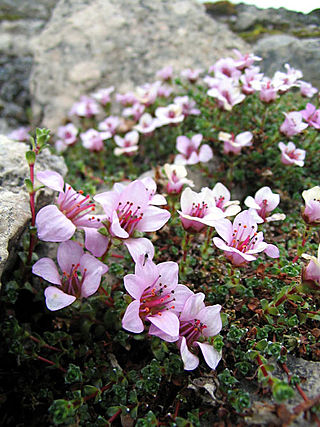
Saxifraga oppositifolia, the purple saxifrage or purple mountain saxifrage, is a species of plant that is very common in the high Arctic and also some high mountainous areas further south, including northern Britain, the Alps and the Rocky Mountains.

Saxifraga paniculata is an alpine species of flowering plant in the saxifrage family, with native distribution in the temperate northern hemisphere. Common names include alpine saxifrage, encrusted saxifrage, lifelong saxifrage, lime-encrusted saxifrage, livelong saxifrage, white mountain saxifrage, and silver saxifrage.

Micranthes nivalis is a plant species in the saxifrage family. It is commonly called snow saxifrage or (ambiguously) alpine saxifrage.

Bensoniella is a monotypic genus of plants in the saxifrage family containing the single species Bensoniella oregona, which is known by the common name Oregon bensoniella, or simply bensoniella. This plant is endemic to the Klamath Mountains of northern California and southern Oregon. This is a plant of the wet forest understory and meadows above 1000 meters in elevation. It is a perennial herb which grows from a rhizome and bears rounded to heart-shaped lobed leaves with woolly petioles and tall, thin racemes of flowers. Each flower is white with bright yellow-pink anthers. The plant produces capsules of abundant seeds but also reproduces vegetatively. When it does reproduce sexually, it often self-pollinates. Bensoniella is not endangered but it is a species of some concern for several reasons, including lack of genetic diversity in part due to its habit of self-pollination and asexual reproduction, its relatively narrow tolerance of habitats, its small range of distribution, habitat destruction due to logging, grazing, and road-building, and erosion. The plant was first collected in 1916 by John Hunter Thompson.

Hoffell is an area and a farmland in southeast Iceland. It is characterised by a large outlet glacier, Hoffellsjökull, and gabbro rock, which originally formed deep in the Earth's crust but is now visible due to uplift of the area and glacial erosion. The Hoffell area is 15 kilometres from the town of Höfn. A guesthouse is located in the area with naturally heated outdoor hot tubs. Marked hiking trails are also to be found in the area.

Bellendena montana, commonly known as mountain rocket, is a species of low-growing multi-stemmed shrub in the plant family Proteaceae. It is endemic to high-altitude subalpine and alpine regions in Tasmania, Australia. The prominent white flower spikes appear over summer, followed by small bright red or yellow fruit in late summer and autumn.
Lithophragma campanulatum is a species of flowering plant in the saxifrage family known by the common name Siskiyou Mountain woodland star. It is native to southern Oregon and northern California, where it grows in the forests and woods of the mountains. It is a rhizomatous perennial herb growing erect or leaning with a tall naked flowering stem. The leaves are mostly located on the lower part of the stem, each divided into rounded lobes, sometimes narrowed into teeth. The stem bears 2 to 11 flowers, each in a cuplike calyx of red or green sepals. The five petals are white, under one centimeter long, and divided into irregular toothlike lobes.

Lithophragma glabrum is a slender perennial western North American mountain plant in the Saxifrage family (Saxifragaceae), known by the common names bulbous woodland star, bulbiferous prairie-star, smooth woodland star, and smooth rockstar.
Micranthes howellii is a species of saxifrage known by the common name Howell's saxifrage. It is endemic to the Klamath Mountains of southern Oregon and northern California, where it grows in moist, rocky habitat. It is a perennial herb growing from a caudex, usually with a rhizome system. It produces a basal rosette of leaves with rounded or oval blades edged with dull or sharp teeth or scalloping. Each leaf is up to 6 centimeters long, thick and fleshy, and borne on a short petiole. The inflorescence arises on an erect peduncle up to 20 centimeters tall. An array of branches bear several flowers with small white petals.

Micranthes tolmiei is a species of flowering plant known by the common name Tolmie's saxifrage, or Tolmie's alpine saxifrage. It is native to western North America from Alaska to Montana to California, where it grows in rocky mountain habitat types, especially in alpine climates, such as talus and fellfields. It is a small perennial herb growing in mats of creeping stems lined with thick, fleshy leaves each up to 1.5 centimeters long. The inflorescence arises on a stout, erect peduncle with a few stubby bracts midway up. The flowers have narrow white petals and petal-like white stamens.
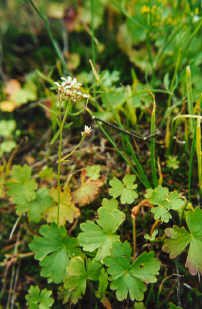
Hemieva ranunculifolia is a species of flowering plant in the saxifrage family known by the common name buttercup suksdorfia. It is the sole species in genus Hemieva. It is native to western North America from British Columbia and Alberta south to northern California. It grows in moist, rocky habitat in mountains and foothills. It is a non-rhizomatous perennial herb growing up to 40 centimeters tall. The leaves have rounded blades up to 4 centimeters wide with several large lobes edged with rounded teeth. The blades are light green, slightly fleshy, hairless in texture, and are borne on petioles up to 15 centimeters long. The inflorescence is a dense, flat-topped cluster of up to 35 flowers borne atop a mostly naked, hairy, glandular stalk. Each flower has a bell-shaped calyx of pointed sepals and five white or pink-tipped petals. The fruit is an oval brown capsule measuring 4 millimeters in length.

Saxifraga aspera is a species of saxifrage known by the common name of rough saxifrage. In German it is known as Rauhhaariger Steinbrech. It is placed in section Trachyphyllum of the genus Saxifraga. There are two subspecies, Saxifraga aspera subsp. aspera and Saxifraga aspera subsp. micrantha. It is a plant of the pan-Arctic tundra and is also found in Europe at moderately high altitudes in the Alps, Pyrenees and northern Apennines.

Saxifraga bryoides is a species of saxifrage known by the common name of mossy saxifrage. In German it is known as Moosartiger Steinbrech. It is an inhabitant of the Alps and other mountain ranges at high altitudes in continental Europe.

Saxifraga globulifera is a flowering plant of the genus Saxifraga and the family Saxifragaceae.
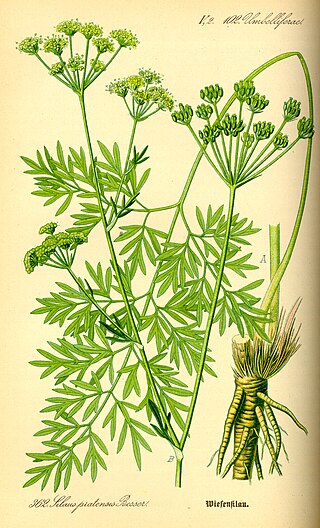
Silaum silaus, commonly known as pepper-saxifrage, is a perennial plant in the family Apiaceae (Umbelliferae) found across south-eastern, central, and western Europe, including the British Isles. It grows in damp grasslands on neutral soils.
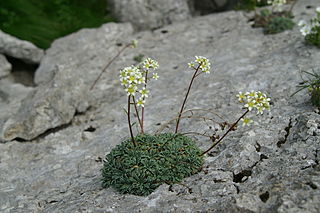
Saxifraga crustata, the crusted-leaved saxifraga and silver saxifrage, as well as encrusted saxifrage, is an evergreen perennial plant species in the family Saxifragaceae, native to the Eastern Alps. This species was described by Austrian botanist Lorenz Chrysanth von Vest in 1804.
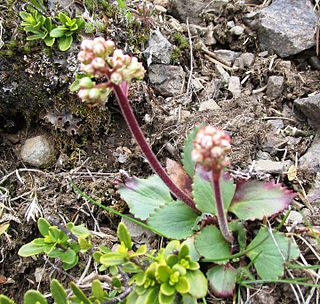
Micranthes occidentalis, commonly known as western saxifrage, is a species of flowering plant native to North America.

Saxifraga bronchialis is a perennial herb in the family Saxifragaceae, with the common name matte saxifrage or spotted saxifrage. It is native to northern Asia and North America.

















